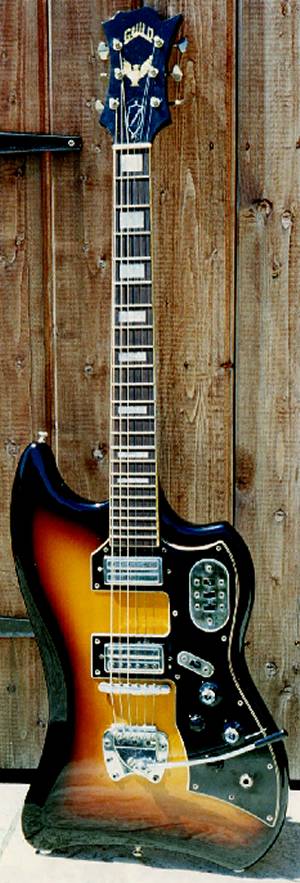
Having established a firm reputation for building acoustics and electric arch-tops during the 1950's, the Guild company of Hoboken, New Jersey, left it until 1963 before dipping their toes into the turbulent waters of the solid-body electric guitar market. They came up with three models: the S-50 Jet-Star, the no-frills, entry-level single pick-up version; the S-100 Polara, same shape, but with two pick-ups and a tremolo arm; and the big ugly sister, the all-singing, all-dancing S-200 Thunderbird, complete with two humbucking pick-ups, tremolo, and Fender Jag-style electronic circuit. Worth waiting for, or what?
These Guild solids are distinguished by an unusual concave bite carved into the bottom of the body, which can stand on two little plastic feet at either edge, making it less susceptible to toppling. In addition, both the Polara and Thunderbird were supplied with an innovative hinged metal stand (see photo), a steel leg recessed into the rear of the body and held in place by a small magnet. The hinges were not really up to the job, many of them snapping under the weight of the guitar.
The large head-stock, which all three models share, is a frankly baffling design, and the Thunderbird features a pearly flying bird inlay, with its name on the truss-rod cover. The tuners are open-backed Grover Sta-Tites, and the huge neck is mahogany. The body of my guitar is two pieces of alder, relatively light and resonant, though some are mahogany. The tremolo tail-piece and bridge - a palm-lacerating incident just waiting to happen - were supplied to Guild by the Swedish company Hagstrom (see Miss January 2002), and is practically useless.
But despite these shortcomings and its ungainly appearance, the Thunderbird is a sturdy, well-built instrument with great tone and sustain, and surprisingly well-balanced for playing when standing up. The pick-ups have individual on/off switches, a tone filter switch, master volume and tone controls, and a secondary fluffy-sounding circuit for the neck pick-up with its own controls, an identical system to Fender's Jaguar. The design team must surely have been Chuck Berry fans, to have named it so aptly!
It's perhaps not surprising that these early Guild solids were unsuccessful, bearing in mind what else was available at the time. With no big-name endorsees beyond Muddy Waters and the Lovin' Spoonful's Zal Yanowsky, relatively few were manufactured, fewer still exported, and are particularly rare here in the UK. In over 20 years of searching, this was the only one I ever saw for sale. I swallowed hard when I saw its re-finished metallic blue paint-job, but most of its bits were intact, so realising I'd probably never find another one I grabbed it.
On removing the blue paint, I discovered traces of green lacquer beneath, and it's possible the guitar was originally shipped in Guild's rare Emerald Green finish. While Jonny Kinkade was spraying the tobacco sunburst I asked for (not a Guild spec, I should add), I set about making a new hinge for the stand, replacing the plastic feet (B & Q to the rescue!), and repairing the wiring which, having been tampered with, looked as if it had been knitted.
Huge, unwieldy and not for the faint-hearted, this is a big-boy's guitar with more going for it than its looks would suggest. Its fashion-victim status makes it, to me, ultra-cool; it's the Jowett Javelin of the guitar world! Perfectly playable and useful in most applications, I love it to pieces, and full marks to Jonny Kinkade for his fabulous make-over.
Recording debut: The Evening Shadows, Steve Hogarth,summer 1996.
Features on: Cathal Coughlan Black River Falls sessions (can't remember which tracks), summer 1998, plus dozens of home recordings.